November 20, 2009
Air Date: November 20, 2009
FULL SHOW
SEGMENTS
Carbon Saturated Ocean
View the page for this story
The Global Carbon Project just released its yearly carbon budget, and they’ve found that our current CO2 emissions put us on track to warm six degrees by 2100. New research suggests that the world’s oceans, responsible for absorbing a quarter of all our CO2 emissions, are maxing out and may not be able to keep soaking up our excess carbon. Host Jeff Young talks with Columbia University researcher Dr. Samar Khatiwala to ask about the ocean’s capacity to keep absorbing carbon dioxide. (06:00)
Coastal Carbon Sink
View the page for this story
Coastal marine environments like mangroves and seagrass meadows capture carbon from the air and use their long root systems to bury it deep within the soil. Host Jeff Young talks with Emily Pidgeon, the director of the Marine Climate Change Program at Conservation International. Dr. Pidgeon speaks about a recent report that demonstrates how these coastal marine areas are 50 percent more efficient at burying carbon than tropical forests. (06:00)
Art of Synthetic Biology
/ Ike SriskandarajahView the page for this story
The tools necessary to create new forms of life are moving from the labs of scientists to the studios of artists. One group of design students got their hands wet in the world of synthetic biology by trying to create a bacteria that smells like the first rain of a monsoon. Living on Earth’s Ike Sriskandarajah reports. (06:45)
Slow City
/ Don GenovaView the page for this story
Cowichan Bay, a small Canadian town, has become the first Slow City in North America. Towns or cities have to meet certain criteria to gain slow city certification - pedestrian walkways, no big box or chain stores, a population of less than 50 thousand. Producer Don Genova visited Cowichan Bay and found a community proud of its newly gained status. (05:35)
Big City, Big Impact
View the page for this story
Big cities can make big strides in protecting the environment. Mexico City Mayor Marcelo Ebrard has ambitious plans for the city’s green future, as well as high hopes for the ability of big cities in general to initiate environmental change. Living on Earth’s Steve Curwood caught up with him during a recent visit to the states. (05:25)
Harnessing the Severn
/ Tom AllanView the page for this story
A tidal project that would put a 10-mile concrete barrier across the United Kingdom’s longest river is generating controversy. The proposed Severn barrage would help the UK produce reliable, renewable energy in its efforts to combat climate change. But critics say the huge tidal wall will harm the river ecosystem. Producer Tom Allan reports. (12:00)
The Language of Landscape
/ Kim StaffordView the page for this story
Living on Earth continues its series exploring features of the American landscape. It’s based on the book “Home Ground: Language for an American Landscape,” edited by Barry Lopez and Debra Gwartney. In this installment, Kim Stafford explains the term “choke point”. (03:15)
Wild Turkey
/ Mark LenderView the page for this story
This time of year, all eyes are on the turkey. But as Salt Marsh Diary writer Mark Lender warns, in their natural habitat these birds don't mess around. (02:35)
This week's EarthEar selection
listen /
download
Show Credits and Funders
Show Transcript
HOSTS: Jeff Young
GUESTS: Samar Khatiwala, Emily Pidgeon, Marcelo Ebrard
REPORTERS: Ike Sriskandarajah, Don Genova, Tom Allan
CONTRIBUTORS: Kim Stafford, Mark Seth Lender, Quincy Campbell
[THEME]
YOUNG: From Public Radio International, this is Living on Earth.
[THEME]
YOUNG: I'm Jeff Young. New science warns we’re maxing out the ocean’s ability to absorb our carbon-dioxide emissions.
KHATIWALA: If you look at it as a carbon budget, then, yeah, we’ve been subsidized by the ocean. So if emissions grow too rapidly the ocean really can’t keep up.
YOUNG: CO2 and the deep blue sea. Also, a science project that’s pure poetry. Trying to capture the smell of the season’s first rain.
SETHI: In the Indian context, rain plays such, such an important part. From the monsoons to Bollywood romance, all of it is somewhere embedded in the rains. Fresh, extremely sensual. Meaning to the extent of erotic. First rain, especially.
YOUNG: Sense and sensibility. Plus, an appreciation for turkeys untamed. Those stories and more this week on Living on Earth – stick around.
ANNOUNCER: Support for Living on Earth comes from the National Science Foundation and Stonyfield Farm.
Carbon Saturated Ocean
[THEME]
YOUNG: From the Jennifer and Ted Stanley Studios in Somerville, Massachusetts - this is Living on Earth. I’m Jeff Young. Developments in both science and politics on climate change: The US and China agreed to cooperate on cleaner and more efficient forms of energy. But world leaders downplayed expectations about next month’s climate summit in Copenhagen. So political leaders sent mixed messages, but climate science sent a clear signal. The international scientists of the Global Carbon Project have a warning about the current trajectory of our CO2 emissions. Their new report, called the Global Carbon Budget, says we’re on a path towards a catastrophic 11 degrees Fahrenheit rise in the planet’s average temperature by the century’s end. Woods Hole Research Center director Richard Houghton helped write the Carbon Budget. He says it compiles the latest data on carbon sources and sinks.
HOUGHTON: We know we’re emitting carbon dioxide through burning fossil fuels and through deforestation. What we don’t know as well is where carbon is going. Only about half what we release stays in atmosphere. And the other half goes back into oceans or goes back into land.
YOUNG: Generally speaking, the sinks, the things that absorb carbon from the atmosphere – they’re not keeping pace with the emissions, it what you’re finding?
HOUGHTON: They’re not quite keeping up and that’s the worry. The point is that nature has been good to us and as these sinks get saturated or start to fill up they will not take up as large a fraction of what’s emitted.
YOUNG: Houghton’s report says natural storehouses of carbon have become slightly less efficient over the past 50 years or so – and two other new studies give us a deeper insight into one of the most important carbon sinks – the ocean. Oceans have been taking up close to a third of all the CO2 humans generate. But research in the current issue of the journal Nature suggests we’ve pushed the CO2 storage of the seas to the limit. Columbia University oceanographer Samar Khatiwala wrote that paper and he’s with us now - welcome to Living on Earth.
KHATIWALA: Thank you. Thanks for inviting me on your program.
YOUNG: Well, what did your study find about oceans and their ability to take up our CO2?
KHATIWALA: So, what we’ve discovered is that starting in about the 1950s or so, there was a really sharp increase in ocean CO2 uptake driven by the very explosive growth in emissions. That uptake is still increasing today, but at a slower pace, so that over time the oceans are absorbing a much smaller proportion of total human CO2 emissions. In fact, as much as ten percent less compared with just ten years ago.
YOUNG: So, just in the past decade it’s ten percent less compared to the emissions we’re putting out there?
KHATIWALA: Right, the proportion of emissions that the ocean takes up has gone down by about ten percent.
YOUNG: Even though the oceans are still absorbing more CO2 than I guess they ever have, right?
KHATIWALA: That’s correct. That, in absolute terms, the oceans are increasingly absorbing CO2. It’s currently about two point three billion tons per year.
YOUNG: Two point three billion tons, that’s how much the ocean is absorbing every year, is that right?
KHATIWALA: That’s correct. It represents about one fourth of total human CO2 emissions. Or to put it another way, it’s about six years worth of US gasoline consumption. So, it’s a very sizable sink for human CO2 emissions.
YOUNG: So, what is the ocean’s ability to absorb this CO2 lessening? What’s going on there?
KHATIWALA: The ocean circulation is really very sluggish, so if emissions grow too rapidly the ocean really can’t keep up. The other reason is what we like to call ‘ocean chemistry’. Basically, as CO2 dissolves in seawater, the ocean becomes more acidic and its capacity to take up more carbon in the future declines. So it’s really a combination of these two factors: ocean circulation and ocean acidification that’s combining to give this reduced uptake – relative uptake of ocean CO2.
YOUNG: So, essentially it’s just it can’t keep up with the emissions we’re pumping out there.
KHATIWALA: Exactly. That’s right. Almost everything, all the feedbacks between climate and the ocean are such that this problem can only get worse. You know, the ocean is only going to get more acidic, there’s nothing to prevent that. The ocean might warm up in the future, and that’s going to release, or make CO2 less soluble in water, for example. So, all these different factors together suggest that CO2 – relative CO2 uptake going into the future is going to decline.
YOUNG: That doesn’t bode well, does it?
KHATIWALA: Not in the long term. You know, in the short term, it’s a small change. But, once you start extrapolating into the future, it’s clearly going to be an important factor. If you look at that total amount of man-made carbon in the oceans at present, it’s about 150 billion tons of carbon, which if I want to put that into some kind of context, if you took all this carbon and you put it into the atmosphere, then atmosphere CO2 would be about 20 percent higher – or about 460 parts per million.
YOUNG: Wow.
KHATIWALA: A lot of scientists think that if you want to abort sort of dangerous climate change, we should be limiting future CO2 to about 450 parts per million.
YOUNG: So, that chunk alone would already put us over right there?
KHATIWALA: Yeah. That would definitely put us over. So, the ocean is really doing its part in sort of preventing that from happening. You know, it’s giving us three or four decades of time so we can get our act together and hopefully reduce emissions.
YOUNG: So, I guess the takeaway lessons here is nature’s kind of been cutting us some slack. We’ve been pumping a lot of CO2 emissions up there and the oceans have been sucking a lot of it up, but we’re maxing out our account kind of here aren’t we?
KHATIWALA: That’s right. If you look at it as a carbon budget, then, yeah, we’ve been subsidized by the ocean and the land.
YOUNG: But the free lunch might be over?
KHATIWALA: That’s correct, yeah.
YOUNG: Professor Samar Khatiwala thanks very much.
KHATIWALA: Thank you for having me on your program.
Coastal Carbon Sink

Mangrove coastal marine habitat (Courtesy of Conservation International.)
YOUNG: The takeaway message from Professor Khatiwala’s study, of course, is that we need to reduce our greenhouse gas emissions. Another report also suggests ways we can help the oceans help us with our carbon debt. The International Union for the Conservation of Nature asked scientists to focus on the role of coastal ecosystems in the carbon cycle. Conservation International oceanographer Emily Pidgeon found these relatively small parts of the planet have a huge capacity to soak up CO2.
PIDGEON: There were three main systems that we looked at in this report that seemed to be able to sequester large amounts of carbon. And they are tidal salt marshes that are found all around the world. In the US we see them all the way along the Atlantic coast and in the Gulf of Mexico. Mangroves – which are sort of a very dominant part of any tropical or sub-tropical coastline. And then sea grasses, which occur globally – we see them a lot in the Caribbean including Florida and throughout the Mediterranean and many other places.

Mangrove coastal marine habitat “Courtesy of Conservation International.)
YOUNG: Now, I think we all know that these are pretty important ecosystems, but why are they important in terms of the carbon cycle?
PIDGEON: Well, all plants, whether they be on land or in the ocean sequester carbon in a number of different ways. The one that we perhaps are more familiar with is absorbing the carbon and using it to grow. So, then the carbon is stored in the actual plant, itself. Whether it be the large trunk of an enormous tree in the Amazon forest or in the leaves of a small sea grass. But, the other way that plants also sequester carbon is by burying it in the soil or the sediment below them. And these marine plants, or marine ecosystems, seem to be incredibly effective at the second type of carbon sequestration. This burying it in the sediment below them.
YOUNG: Why is that?
PIDGEON: There’s a couple different ways they do it. The two main ones are they have these incredibly deep root systems. If you can imagine they’re all living in the sort of tidal or wave dominated part of the coast and they’re holding on for dear life with these deep root systems. And it’s through this deep root systems that they can pull carbon out of either the water or the air and then pump it down in to the sediment and push it out. There is also these areas that are really good for capturing sediment that is in the shallow water, and by doing that that settles down and also captures lot of carbon that way.
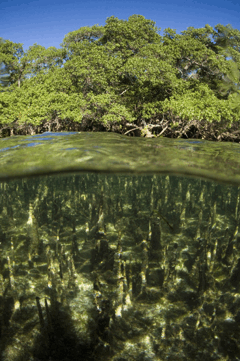
Mangrove coastal marine habitat (Courtesy of Conservation International.)
YOUNG: Okay, so give me a sense of scale here – how do these marine ecosystems measure up as a carbon sink compared to the ones we’re more familiar with; let’s say, forests?
PIDGEON: Well, because these areas are so small compared to those forests. If you think about their actual storage in the plant – they’re probably not that large in terms of carbon storage, compared to tropical forests. But then when we get to look at this sequestration ability, this ability to bury it in the sediment below them, which can be up to 50 times more efficient than the tropical forests. Then you begin to see the fact that these areas are really very important. Sea grasses bury the carbon literally meters into the ground and it can stay there for centuries and millennia. Whereas the tropical forests really just aren’t as efficient at burying the carbon into the soil below them.
YOUNG: Boy, we sure aren’t very grateful in the way we treat them – we’re destroying these areas like crazy, aren’t we?
PIDGEON: Yes, that’s very true. And we have been doing so for a very long time. All these coastal areas have really suffered from all sorts of coastal development, whether it be draining salt marshes to build cities and towns. Whether it be building large port facilities, or just clearing mangroves because we’d prefer to look at the beach and the water than actually just mangrove forest areas. We’re losing these areas significantly.
YOUNG: So, going back to looking at them through the lens of their place in the carbon cycle, and their ability to sock away carbon. What are we losing when we lose those mangroves?

Photo of Dr. Emily Pidgeon.(Courtesy of Conservation International.)
PIDGEON: The mangroves, the number that is being used at the moment is that 20 percent of the total mangrove coverage has been lost since 1980. This is the equivalent of losing about 6,000 or nearly 7,000 square kilometers of tropical forest in sequestration capacity, into the soil. So, if we look at mangroves and sea grasses together. The losses we see for each of those habitat types – we’re losing carbon sequestration capacity at almost the same rate that we are losing tropical forests from the Amazon. It really just underlines that we need to be protecting these coastal systems, worldwide.
In the US, they’re very important for fisheries and for coastal protection. And in many parts of the developing world, in Southeast Asia for instance, these coastal systems provide livelihood and food for entire communities. They’re also very important for allowing people to start to cope with the impacts of climate change. Whether that be sea level rise or increased storms. Marshes, mangroves and sea grasses help protect them against increasing erosion, and against inundation. And so this is really just underlining that we need to be really re-doubling our efforts at protecting these systems.
YOUNG: Emily Pidgeon with Conservation International. Thanks so much for your time.
PIDGEON: Thank you.
Related links:
- To read the IUCN report click here
- To learn more about Conservation International click here:
- Ocean Carbon Sink
- Global Carbon Budget
YOUNG: You can check out all three of these studies on the carbon cycle at our website, LOE dot org.
[MUSIC: The Meters “Aint’ No Use” from ‘Rejuvenation’ (Atlantic Records -1974)]
YOUNG: Coming up – the marriage of art and science in the search for the smell of rain – keep listening to Living on Earth!
Art of Synthetic Biology
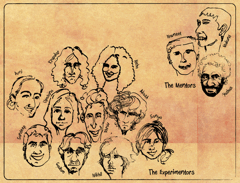
The members of ArtScience Bangalore. (Courtesy of ArtScience Bangalore)
YOUNG: It’s Living on Earth, I’m Jeff Young. College and high school students from around the world traveled to MIT for an unusual event called IGEM – the International Genetically Engineered Machines Competition. The students build novel forms of life from biological parts. The field of synthetic biology is expanding, and so is the sphere of those who use it. Living on Earth’s Ike Sriskandarajah found out what a team of artists brought to the science competition.
[VOICES TALKING IN CROWDED ROOM]
SRISKANDARAJAH: At first glance, IGEM looks like summer camp. Kids in matching team shirts swarm around talking about their projects – except the arts and crafts here are new life forms.
THATTAI: It’s true, there’s some cool science going on.
SRISKANDARAJAH: Mukund Thattai, an IGEM veteran, who runs a leading synthetic biology lab in Bangalore points out a team that made bacteria that grow bright yellow when they touch land mines. Then there’s the team with bacteria that find and seal microscopic leaks in water pipes.
THATTAI: If you told somebody up front that undergrads would be working on this, they’d come up with their own ideas. Not that it’s going to work, even if they were attempting it, they would laugh at you. If you were more experienced you wouldn’t try this. There’s no lack of ambition, isn’t not that…what is that word?
SETHI: Gumption.
THATTAI: Gumption. Exactly. Exactly.
SRISKANDARAJAH: Mukund advised the wildest team of all: Art Science Bangalore. Team member, Avni Sethi:
SETHI: As artists and designers, there is a certain gumption that comes into the picture. And that is sort of the basis of anything that we’d end up doing.
The rain plays an important cultural role in India. Most Bollywood films feature at least one "wet" scene.
SRISKANDARAJAH: So, teammate Upanasa Simha says they felt like they could do anything.
SETHI: We don’t know anything technical. We don’t know whether anything is possible but that fact that that’s not restricting us in any which way it’s so…we’ve got a crazy imagination for bacteria and so we imagined all of it, and then drew it with paint and paper.
SRISKANDARAJAH: They dreamt and drew strange microbial creatures like lie-detecting bacteria – bugs that would destroy materialism.
SETHI: And one of the things that we drew was something called “action dopamine”, which was this bacteria that would sense love. And as it would sense love, it would start smelling of rain. So, that was the initial idea.
SRISKANDARAJAH: But their imagination hit a scientific roadblock.
SETHI: If we were to do something like that we’d have to work with neurotransmitters, and in this case dopamine, and that would have been extremely complex.
SRISKANDARAJAH: So, they simply bypassed it.
SETHI: And then we sort of focused on the smell of rain.
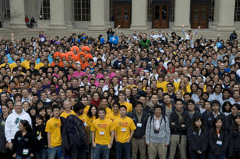
Over 110 teams from around the globe attended the iGEM Jamboree. (Photo iGEM and David Appleyard.)
SRISKANDARAJAH: Specifically, the first monsoon rain.
SETHI: Especially in the Indian context. Rain plays such, such an important part. Meaning, from the monsoons to Bollywood romance, all of it is somewhere embedded in the rains.
[STRAINS OF BOLLYWOOD SONG BEGINNING]
SRISKANDARAJAH: Like this song from the 1994 classic “Mohra.” The raining water kindled a fire.
[WOMAN SINGING HINDI “TIP TIP BARSA PAANI”]
SRISKANDARAJAH: What is the first rain, like if you had to use words to describe it?
[SOUNDS OF CROWDED ROOM; VOICES CHATTERING]
SETHI: Fresh. Extremely sensual. Meaning, that I can go on to saying to the extent of erotic. First rain, especially.
SRISKANDARAJAH: Which is the steamiest description of a science project I’ve ever heard.
[BOLLYWOOD MUSIC CLIMAX]
SRISKANDARAJAH: They had the passion and the imagination, but to flesh out the poetry they needed science.
SETHI: It started off with just looking up the internet saying, okay what is cell, what is gene, what is DNA? Right from there we went through eleventh standard biology definitions of all of these things. And then slowly in the lab was, how do you see a DNA? So, step-by-step, it got a little more complicated. So, we took this little bit – I feel love, it smells of rain – to the lab and then the lab said, well, a lot of this seems possible, but let’s work backwards.

The members of ArtScience Bangalore. (Courtesy of ArtScience Bangalore)
SRISKANDARAJAH: So, working backwards from the smell of rain to its chemical source.
SETHI: Geosmin. Which is a metabolite that is responsible for the smell.
SRISKANDARAJAH: Geosmin means literally “smell of the earth”. It’s created by algae that live in the dirt. The team ID’d the genetic instructions that make Geosmin and plugged them into the common, lab-friendly bacterium, E. coli.
SIMHA: So, now when we insert this into our E. coli it should essentially produce Geosmin.
SRISKANDARAJAH: And it did!
SETHI: The moment we opened that little test tube. I was like, “Mmm, rain!” [Giggles]
SIMHA: And it came back all as, “We’ve do it! It smells of rain and everything.”
SRISKANDARAJAH: Though, it wasn’t as evocative as they’d hoped.
SETHI: It was a little musty, but it was certainly wet. Yeah. But, apparently, that’s how E. coli kind of smells. So, maybe it smells like E. coli and something else. [Laughs]
SRISKANDARAJAH: But the damp bug smell isn’t all that art-science achieved. On the last day of the competition the judge announced the winning teams.
JUDGE: In determining the award for best presentation, what we felt was most important was how well you’re able to teach everyone through your presentation. So, for teaching us about extreme resourcefulness, wild creativity, and raw tenacity the award goes to Art-Science Bangalore!
[CHEERING CROWD AND APPLAUSE]
SIMHA: We were really surprised that we won.
SRISKANDARAJAH: The team also succeeded in washing away the old approach of synthetic biology.
SIMHA: The judge said that like the steam changed the way that one of the judges used synthetic biology. So, I was like, “wow, that’s really cool.”
SRISKANDARAJAH: The experience changed their point of view, as well. Dissolving the divisions between art and science. And, inspiring them for next year’s project!
SETHI: Well, when you’re walking down New York City every, every like 20 meters that you walk you smell a new smell.
SIMHA: Next IGEM, next IGEM we will like recreate the different smells in New York.
SRISKANDARAJAH: For Living on Earth, I’m Ike Sriskandarajah.
Related links:
- The ArtScience team has documented their process here
- Hackteria
- Art Science presentation
[MUSIC: Alka Yagnik/Udit Narayan “Tip Tip Barsa Paani” from ‘Mohra Soundtrack’ (Venus Records - 1994)]
Slow City
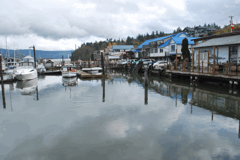
(Photo: Don Genova)
YOUNG: A village in British Columbia has scored a North American first by becoming something called a Cittaslow, or Slow City. A Slow City is an offshoot of the Slow Food movement; it’s a sort of quiet resistance to fast lane, drive-thru homogenization. The seaside town of Cowichan Bay, north of Victoria on Vancouver Island, doesn’t have a single fast food restaurant in sight. As Don Genova reports, the villagers want to keep it that way.
[RAIN SOUNDS; SEAGULL SOUNDS]
GENOVA: It’s a grey, rainy morning in Cowichan Bay. Seagulls call, fishing boats bob gently at the pier. A hungry sailor arriving from dockside won’t find a McDonald’s or KFC in this town. Instead, eateries are called the Rock Cod Cafe and the Masthead Restaurant. Radway Fair Trade and Cow Bay’s Pirate Shack take the place of The Gap and Costco.

(Photo: Don Genova)
[SOUNDS OF BAG RUSTLING; WOMAN SAYING, “I’D LIKE A LOAF OF THE PANNED LOAF MULTIGRAIN, SLICED, PLEASE, FOR STARTERS”; SLICER MOTOR SOUNDS]
GENOVA: The True Grain Organic Bakery sits in the middle of the narrow strip of shops lining the seaside. A slicer carves through fresh loaves of bread as Bruce Stewart emerges from the milling room. He’s owned the bakery for two years now.
STEWART: Yeah, my wife Leslie and I were living in Toronto, and for a little while after that we were living in Calgary, and we decided that it was time to start a family, and we realized that we didn’t want to raise our children in a large city, having both grown up in small communities.
GENOVA: The previous owner had started a ball rolling, and Stewart quickly found himself leading the bid to designate Cowichan Bay a Cittaslow, Slow City.
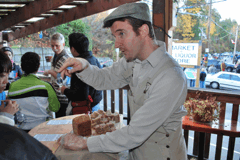
Bruce Stewart owns the True Grain Organic Bakery and led the bid to make Cowichan Bay a slow city. (Photo: Don Genova)
STEWART: What Cittaslow is going to allow us to do is take all the hard work that’s been done by so many different individuals and so many different groups and put it all together and allow us to use it as a framework and move forward to do better. We can be doing a lot better in terms of recycling in the community; we could be doing a lot better in terms of environmental infrastructure.
GENOVA: Cittaslow is an international network of 120 towns in 16 countries. It was founded a decade ago by mayors of some small historic towns in Italy, looking for a way to preserve their culture. They were helped by the same man who founded the Slow Food movement, Carlo Petrini. Mara Jernigan is the president of Slow Food Canada.
[CROWD SOUNDS]

(Photo: Don Genova)
JERNIGAN: So they started to identify the characteristics that defined that kind of cultural identity for a town, so pedestrian walkways, you know, bicycle, not too much light pollution, and just decided to put together Cittaslows.
[VOICES TALKING IN CROWD]
GENOVA: It seems like the whole town of 3,000 is on the docks of the Cowichan Bay Maritime Museum, preparing for a Cittaslow celebration. Towns must have fewer than 50,000 people to qualify. They are judged on many factors: environmental policy, land use, availability of local food ingredients, encouragement of craft products and independent businesses. Marks are even given for a community’s friendliness and hospitality. Jernigan says Cowichan Bay was an ideal candidate given how it stands out from neighboring urban areas.
JERNIGAN: You know just south of here in Langford it’s full of big box stores, and we’ve got fast food restaurants all over the highway in Duncan, I think one day I counted and there’s 16, within a one-kilometer basis right in the heart of downtown Duncan and that kind of thing is really destructive to the health and the economies of small, local places, and Cowichan Bay, you know, for one reason or another, is different. It’s more about what we’re not, you know.
MAN: I’m honored to have the privilege to officially announce that Cowichan Bay is North America’s first Cittaslow community.
[APPLAUSE AND CHEERING; CROWD SOUND]
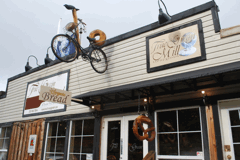
(Photo: Don Genova)
GENOVA: A crowd welcomes the announcement, the celebration made more complete with local wine, seafood and bounty from nearby farms. The Cittaslow committee is a volunteer group. But keeping the nature of Cowichan Bay intact is in the hands of politicians who pass municipal bylaws and approve changes in zoning. Cowichan Bay is an unincorporated village, administered by a much larger regional council, which has approved big box growth in other areas. Lori Iannidinardo sits on that council. She says a new Official Community Plan is in the works.
IANNIDINARDO: It’s the community’s input, it’s not my say, it’s the community making this document, it is a living document, but it’s also, if a developer comes and they have a look at our official community plan, they’ll go wow, this is the style of this community, this is the design, and we hope to work on that.
GENOVA: It’s not just developers that will get the message. Guests to Mara Jernigan’s farmhouse bed and breakfast are quick to pick up the feel of the region.
JERNIGAN: By the time they leave they say, ‘Wow, I feel like I met all these people in the community, I know where the chicken comes from, I know where the vegetables come from, where the cheese and the bread’, and that’s a very, very special thing that we have.
[SEAGULL SOUNDS; WATER SOUNDS]
GENOVA: Naramata in British Columbia will join Cowichan Bay to become Canada’s second Cittaslow, and Sonoma, in California, will become the USA’s first Cittaslow at the end of November. So, it looks like this idea of slowing down life in small towns in North America is gathering speed. For Living On Earth, I’m Don Genova in Cowichan Bay, British Columbia.
YOUNG: Well, you can see pictures of Cowichan Bay and learn more about Slow Cities at our website, LOE dot org.
Related links:
- Cowichan News Leader article on Cowichan Bay becoming North America's first slow city
- Citta Slow originated in Italy. Here's a description of some slow Italian towns.
- Slow Movement
[MUSIC: Darcy James Argue’s Secret Society “Redeye” from ‘Infernal Machines’ (New Amsterdam - 2009)]
Big City, Big Impact

Paseo de la Reforma as seen from Torre Mayor (Photo: Creative Commons.)
YOUNG: Slow cities are, by definition, small cities. Some big cities are making environmental progress, too. By rethinking how people get around. Mexico City’s Metrobus project has cut CO2 emissions by an estimated 80,000 tons a year. Living on Earth reported on Metrobus when it started up in 2005.
[BUS SOUNDS]
JEFF: We spoke with former city environmental minister Claudia Scheinbaum.
SCHEINBAUM: We have substituted 350 buses for 80 buses, and the 350 buses used to be very old buses, so you have reduction in both in local pollutants and greenhouse gas emissions.
YOUNG: Mexico’s Metrobus was just honored by Harvard University’s Kennedy School of Government for its success. That’s where Living on Earth’s Steve Curwood caught up with Mexico City Mayor, Marcelo Ebrard. The mayor has ambitious plans to green the world’s largest cities.
CURWOOD: You’re off to Copenhagen. The 40 largest cities in the world, I believe, have come together, and a group of you mayors will be there. What do you expect to accomplish in Copenhagen as a mayor?
EBRARD: Well, we want to have an agreement between the most important cities of the world. And then to propose and to pressure the national governments and the global institutions to go faster than they go right now. And based in the effort that the cities already are doing. You take a look at Toronto, even New York, or San Francisco, or London. Every city in the world, the mayor part of them, are taking measures seriously, and fastly. And this is a global issue, so we cannot wait for the national governments to take the initiative because they are behind right now.
CURWOOD: So, what do you do to get national governments to move? What do you do to get your own government to move?

Metro Station in Alameda Central Park (Photo: Hajor, June 2004. Released under cc.by.sa and/or GFDL)
EBRARD: Well, we are pressuring every time to the government in our own country. I think that they understand that they should move faster. And we have an agreement because our plan in the city requires national decisions, for instance, what about the diesel? What about the car industry technology?
Should be a national-level decision, but the city have taken several measures in the past two years that move or pressure the federal government to move faster. For instance, we are going to have in Mexico City in 2011 the electrical cars from Japan and maybe, maybe United States. Maybe, I don’t know. So, this requires a new kind of decision from the federal level in order to supply the energy to the users of those cars, and to improve the regulations about the car industry technologies in Mexico. So, we are going to do this, at the same time the United States, UK, and the Canadian cities. So, it’s going to be a really important pressure to change the regulations in all those countries.
So, as far as I can see, the cities can lead these kind of decisions and really change things in the short term. Because, otherwise, we are going to wait – what, another five years? So, what’s going to happen?
CURWOOD: Now, if you look at the political spectrum, you’re considered more progressive, more to the left than your national government at home, which is considered to the right, more conservative. How do you overcome that gap, to get cooperation on these things?
EBRARD: So, we are talking to the young people, to the middle classes, also. In order to put these green issues at the top of the agenda and it’s working out.

Paseo de la Reforma as seen from Torre Mayor (Photo: Creative Commons.)
CURWOOD: Recently, I think you increased the number of days you can’t drive a car. You started to include Saturday, so that means that in any given Saturday, what a fifth of your voters are unhappy with you.
EBRARD: Well, you know, 80 percent of the people in the city uses right now public transportation facilities – 80 percent. So, it’s very different the situation in Mexico City than here. But, on the other hand I think that if you really want to do things – several times you take positions there are no popular measures, but can be effective. So, you cannot only run the city with service in the short term.
CURWOOD: Some might say that you’re positioning yourself to run for president in 2012. That if the national government doesn’t perform, you’ll hold up Mexico City as a green example on other issues to bolster your candidacy for president – what do you say?
EBRARD: Yes, why not? Why not, we need more equal society in Mexico. And new ideas about innovation. Let’s think in the 21st century, and not the 1st century. So, why not?
YOUNG: Steve Curwood talking with Mexico City mayor Marcelo Ebrard.
Related link:
Living on Earth’s 2005 story Mexico Transit
[MUSIC: Brownout “Framed By Death” from ‘Aguilas and Cobras’ (Six Degrees Records - 2009)]
YOUNG: Just ahead – the United Kingdom wants more renewable energy, including tidal power, but a plan for a huge wall at a river mouth is making waves.
WRIGHT: Put a barrage across like that, the barrage's effectiveness will not be a hundred years, it probably will only be ten years. It'll just be mind-boggling. It’ll just silt the whole place up, and turn the whole place into a vast bog.
YOUNG: The pros and cons of harnessing the River Severn. Stay with us on Living on Earth.
ANNOUNCER: Support for the environmental health desk at Living On Earth comes from the Cedar Tree Foundation. Support also comes from the Richard and Rhoda Goldman fund for coverage of population and the environment. And from Gilman Ordway for coverage of conservation and environmental change. This is Living On Earth on PRI, Public Radio International.
Harnessing the Severn
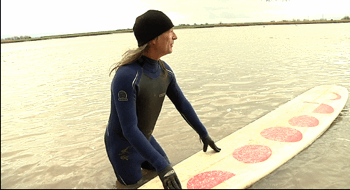
Donnie Wright gets ready to catch the wave running up the Severn. (Photo: Tom Allan)
YOUNG: It’s Living on Earth – I’m Jeff Young. This year the European Union passed ambitious new energy standards — 20 percent of total power from renewable sources by 2020. That’s a challenge for the United Kingdom, which is one of Europe’s worst performers on renewable energy. The UK government wants to tap into the country’s great potential for wind, wave, and tidal power. But proposals to harness the River Severn are so far generating mostly controversy.
At 220 miles, the Severn’s the UK's longest river. But what attracts clean energy engineers is the tidal action at the river’s mouth. Its estuary has the second greatest tidal range in the world. Capturing the energy of that tidal flow could meet five percent of the entire country’s electricity needs. But Tom Allan reports that some fear it could be disastrous for this renowned river.
[DAWN SOUNDS: BIRDS, WATER]
ALLAN: It's dawn on the banks of the River Severn in the Southwest of England. The river flows in sluggish channels past wide sand banks and shallow, muddy areas before emptying into the Bristol Channel, and then the Atlantic.
[DISTANT ROAR BEGINS TO BUILD]
ALLAN: There's a roar in the distance. Downstream, dozens of surfers and kayaks ride a wave.
This is no ordinary wave. This is the Severn bore, a tidal surge caused by the funnel shape of the Severn, and the enormous difference between its high and low tides - as much as fifty feet. The wave travels upstream, against the current.

Donnie Wright gets ready to catch the wave running up the Severn. (Photo: Tom Allan)
[CRESCENDO AS THE WAVE HITS]
WRIGHT: Too much wind that one ... but can't complain. Got a nice little ride while it lasted...
ALLAN: Donnie Wright has surfed the bore for fifteen years. With his long grey hair and black wetsuit, he looks like an otter.
WRIGHT: It's the loneliness of the experience. It's just you and nature.
ALLAN: It's clear that the Severn means more to Wright than just surfing.
He leans forward earnestly as he searches for the words to describe the iconic river.
WRIGHT: The Severn is a river, which has been flowing, determined by the tide, the diurnal tide, twice a day, in and out...the bed scars, the banks get flooded, fertilized. It is a magical place.
ALLAN: For Wright, the river is almost sacred – something to be treated with respect.
But for others, the river is a potential resource to be harnessed in the fight against climate change.
The UK Government is currently considering a number of renewable energy schemes for using the Severn. One of the main proposals is a barrage across the mouth of the river - a massive wall of concrete blocks ten miles long.
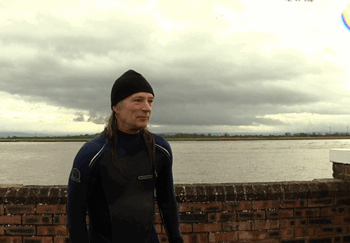
Surfer Donnie Wright. (Photo: Tom Allan)
When the tide comes in, the barrage would trap and hold the water, then release it through hundreds of turbines. Proponents say it would generate and average of 2,200 megawatts a year. That’s equal to a little more than two large power plants, and enough electricity for three million people - an enormous source of clean, predictable, renewable energy for the next century.
But to the dismay of some, it would halve the river’s tidal range, and end the run of the bore. Again, Donnie Wright.
WRIGHT: This River will just die. Put a barrage across like that, the barrage's effectiveness will not be a hundred years; it probably will only be ten years. It'll just silt the whole place up, and turn the whole place into a vast bog.
ALLAN: Critics of the barrage, point to the Bay of Fundy in Canada, the highest tidal range in the World. There, a small barrage caused both silting and coastal erosion. On the other hand, a barrage at La Rance in France has been a reliable source of energy for forty years, without silting.
Chris Morgan of the Severn Tidal Power Group, the consortium behind the UK barrage proposal, says silting shouldn't be a problem.
MORGAN: The sediment is moving continuously up and down the Severn Estuary, it's carried in on the high spring tide, and it’s carried out on the low spring tide. It's not predominantly coming down the rivers. Therefore creating a barrier across the Severn estuary is not going to make the impounded area silt up.
ALLAN: Experts at the Cardiff School of Engineering in Wales agree. Their studies show that after an initial deposit of about a foot of silt, only small amounts will be added over time.
The Severn Tidal Power Group is counting on the barrage to operate for at least a hundred years. It has to, say critics, to justify its enormous construction costs – estimated at around 30 billion U.S. dollars. The Government is looking at how best to finance the project. Whatever they decide, it's likely to be an expensive way to produce electricity.
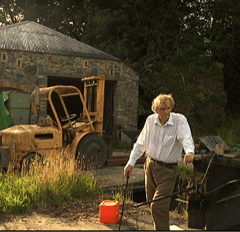
Inventor Rupert Armstrong Evans designed a low-lying tidal reef to harness the River Severn’s tide power. (Photo: Tom Allan)
But, Chris Morgan says that the barrage is an essential part of the energy mix - if the UK is going to meet its 2020 targets to combat climate change.
MORGAN: It has the possibility to produce at least five percent of the UK's electricity from an entirely renewable and carbon-free generating source. We need the electricity, we need the energy, and it needs to come from clean and renewable sources.
ALLAN: Clean energy from the tides – it's a compelling vision. But whether a Severn Barrage would provide truly green energy is debatable – because of the impact it would have on wildlife and habitats.
[SOUND OF THE ELVER FARM]
ALLAN: Surfers aren't the only creatures that hitch a lift on the river tides. Baby eels – elvers - use it, too.
[SOUND OF DOORING OPENING, WATER POOLS]
COOK: These are the elvers.
ALLAN: Horace Cook and his family have been fishing and farming elvers for decades. He holds up a handful of the tiny transparent creatures, wriggling with energy.
COOK: Marvelous animals, absolutely fascinating creature, mysterious, unbelievable. We know very little about them, let’s face it.
ALLAN: When Cook was a boy, elvers were a cheap meal, fried with bacon by the thousands. They were so abundant that they were even fed to cattle. Nowadays, a pound could cost you about 150 dollars.
Cook exports his elvers to help restock other rivers around the world. The Severn, he says, is ideal for the young eels.
COOK: The Severn has this wonderful tidal influence. We have a large tidal bore that comes up. These little animals use that energy to get up into the river.
ALLAN: Horace isn't too worried about the barrage project – he thinks his little elvers can adapt to changes to the river. But disruption to migratory passages and injury by turbines would have a major impact on these eels, as well as on salmon, and shad, according to the Sustainable Development Commission, an independent watchdog that advises the government.
And other animals that depend on the tidal cycle are certain to be affected.
[SOUND OF WATER AND MUDDY FOOTSTEPS]
ALLAN: Back on the riverbank at low tide, and the bore has washed up a thick layer of rich, slippery mud that coats everything. Downstream, birds are returning to the mudflats that had disappeared with the flood.

Engineer and inventor Rupert Armstrong Evans. (Photo: Tom Allan)
These intertidal mudflats are an important habitat for thousands of wading birds and waterfowl, says Richard Inger, a researcher at the Centre for Ecology and Conservation at the University of Exeter.
INGER: What might just look like a plain bit of mud to us actually is a restaurant to many bird species. If you go down below the top layer of the mud, there's hundreds and thousands of different species of worms and arthropods that use this as their home. And that's what the birds go for, you know, it's a real larder for them.
ALLAN: Inger says the barrage would permanently flood these mudflats - closing the larder door.
INGER: If a barrage is put across the whole of the Severn there will be a loss of large areas of intertidal habitat, which will undoubtedly impact a lot of the species that use these areas as feeding grounds.
But perhaps surprisingly, Richard Inger actually supports the barrage proposal.
INGER: Finding new ways of producing energy's always going to be difficult, and there are always going to be some environmental impacts. But if we think of this on a national scale, and on an international scale, the importance of reducing carbon emissions and the effects of climate change are far more important than small scale impacts at a local level.
ALLAN: A majority of the public agree. In a survey conducted by the Sustainable Development Commission in 2007, 58 percent of people were in favor of a barrage, and only 15 percent were against.
But the loss of such a unique habitat remains the major sticking point for leading environmental groups. They say that you don't have to choose between combating climate change on the one hand, and loss of precious habitats on the other. Instead, they've waded into the engineering side of the debate, backing alternatives to the barrage.
Friends of the Earth are backing an offshore lagoon design. Instead of a wall, round or oval lagoons would stand freely in the river estuary, filling up and emptying without stopping the tide.
And the Royal Society for the Protection of Birds has helped fund a tidal reef proposal by engineer and inventor Rupert Armstrong Evans.
[SOUNDS OF THE FARM, AND WATER]
ALLAN:At his ramshackle Cornish homestead Evans shows me his garden, surrounded by water mills and barns filled with hydroelectric machinery. He founded one of the countries first renewable energy companies in the 1970s. The company specializes in small-scale, hydroelectric schemes, including community projects in Brazil, Africa and India. Financing his reef proposal has meant taking out loans, and re-mortgaging some of his property - but he feels passionately that an alternative to the barrage must be found.
EVANS: If you build a barrage and you get it wrong you can't do anything about it. You have millions of tons of concrete there - short of blowing it up, you're stuck with it.
ALLAN: Mr. Evans says that his low-lying reef would generate just as much energy as the big barrage, but without the environmental impacts. By harnessing a greater volume of water, rather than creating a large height of water, it would avoid disrupting the tides as dramatically. Less of the mudflats would be submerged, and the slower turbines would kill fewer fish.
He says that a new approach to engineering is needed – one that starts with the environment, not the machinery.
EVANS: I don't think that it's a major problem to make the engineering work in a way that is sympathetic to the Severn, so that you're working alongside the natural rhythm of the tide, rather than being a monolithic structure that imposes itself on the river and can cause an environmental disaster.
ALLAN: Much to Evans' dismay, the large engineering consortium of Rolls-Royce and Atkins has just been awarded government funding for a strikingly similar scheme. The Severn Embryonic Technologies fund was recently launched, giving $800,000 to three proposals that promise to harness the Severn without having major impacts on the environment.
But, so far, the government seems to favor the more established large barrage design - despite warnings from its own Environment Agency that it should not be built because it would be ecologically damaging.
Time is running out. With the 2020 emission reductions targets looming, the pressure is on to get started on one of the projects as soon as possible.
The government has said it will make a decision next year.
Until then, the debate about how best to harness the energy of the remarkable Severn promises to be as turbulent and unpredictable as the river itself.
For Living on Earth, I’m Tom Allan in Newnham on Severn.
[WAVE CRASHES]
Related links:
- Read the report by Sustainable Development Commission.
- Severn Tidal Power Group
- Researcher Richard Inger resume
- The Severn Embryonic Technologies Scheme
- Rupert Armstrong Evans Tidal Reef Plan
- Elvers in the Severn
[MUSIC: Daniel Lanois “O Marie” from ‘Acadie’ (daniellanois.com - 2002)]
The Language of Landscape

YOUNG: The Severn bore is a unique phenomenon with its own unique name. Many features of the landscape carried intriguing and evocative names as we learn in our series, Homeground. Poet Kim Stafford gives us his definition of “choke point”.
STAFFORD: The choke point -- the Achilles heel in a dynamic system where forces of flow and resistance bottleneck -- has become a notion used in a variety of contexts. For land travelers, the choke point may be a narrow defile where a path crosses a ridge at a point hemmed tightly by flanking cliffs. For hydrologists, the choke point may be a constriction in a stream channel where sedimentation builds as flow is blocked. The restless drama of such a position in stream or path has caused this term to become a metaphor attractive to military strategists, economists and computer consultants, whereby, for example, the clog of email may threaten worker efficiency just as a wilderness hiker may need to exhale to slip through a tight spot.
YOUNG: Essayist and poet Kim Stafford lives in Portland, Oregon. His description of choke point comes from the book Homeground: Language for an American Landscape, compiled by Barry Lopez and Debra Gwartney.
[MUSIC: Bill Frisell “Wildwood Flower” from ‘Ghost Town’ (Nonesuch Records - 2000)]
Wild Turkey
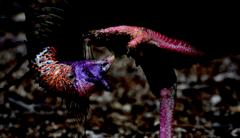
(Photo: Mark Seth Lender (c))
YOUNG: For most Americans, Thanksgiving dinner means turkey. But as Mark Seth Lender cautions, if you’re thinking of making a meal out of a Wild Turkey, better think twice.
LENDER: Turk-turk turkey comes jerk-jerk lurking on, tip to toe. Cautious, like ice just itching to melt. Through parkland, under low-lying limbs drip-drip-dripping with dew. Patient like mud settling where deer, galumphing, stirred up still water. Driving slow and low and through and through from tall grass to scrub. Look at them go.

(Photo: Mark Seth Lender (c))
Tough. Bad. Ain’t no Butterball, ain’t no Song Sparrow. Checking out the quiet part of the woods ahead of would-be girlfriends, might be lovers, always moving cover to cover. Then right behind taking their sweet time wouldn’t you know, here those Birdie-Birds come, tut-stut strutting their stuff, proud and tall and don’t gonna be no one’s – I say, no one’s stuffin’! They might look sweet.
First best think on this: Before you get to the eats have to beat down twenty pounds of lean, mean muscle armored like a weaponeer. Got spurs on the backs of their legs sharp as a thorn. Got a beak that means business. Fly straight up, chase Someone down the block, wreck SOMEONE’S whoooole day. So back away. Keep on lickin’ your lips, that “Someone” gonna be YOU! Morning catches the sheen, at shoulders, back, cusp of wing, iridescent as Mother of Pearl but these ain’t no Pretty-pretty Peacocks, no Birds of Paradise makin’ nice.

(Photo: Mark Seth Lender (c))
Don’t be calling these turkeys “Turkey” to their face. Feathers broad and flat as dragon scutes, breath like Mace. Neck like a reptile, long and ropey. Glaring; Staring; Violet, blue and crimson red. Horn of flesh in the center of the head. Bald as a vulture. Eye as dark as obsidian glass. Feet that leave a four-inch track. Pickin’ their toes with a clickety clack! Like those who have risen from the sea and crawled back in (seal and sea lion, whale and dolphin) some take to the sky only to return to land: Wild Turkey, that Jabberwock, weighty presence, work of art. Less than the sum, more than the parts.
Related link:
Link: Salt Marsh Diary
[MUSIC: Ray Bryant “Hot Turkey” from ‘Hot Turkey (The Definitive Black And Blue Sessions)’ (Disques Black & Blue - 1975)]
YOUNG: Mark Seth Lender writes a column called “Salt Marsh Diary.” To see some of his photographs, go to our website at LOE dot org.
[CIDER PRESS SOUNDS; LIQUID DRIPPING; MOTOR RUNNING]
YOUNG: We leave you this week in the apple orchards of Vermont.
[CIDER PRESS]
YOUNG: Now, if you’re not drinking Wild Turkey with your Thanksgiving feast, you might find that New England cider could be a fitting accompaniment.
[GURGLING CIDER]
YOUNG: Living on Earth’s Quincy Campbell sampled the sounds and taste of the hot ginger apple cider brewed by Shelburne Orchards in Shelburne, Vermont.
MAN: We got 50 gallons of sweet cider here, and 40 pounds of ginger, freshly ground up this morning. And we cook it in here at about 180 degrees for eight hours – and then we’re going to bottle it tonight.
[MILL PRESSING APPLE]
YOUNG: Living on Earth is produced by the World Media Foundation. Our crew includes Bobby Bascomb, Eileen Bolinsky, Bruce Gellerman, Annie Glausser, Ingrid Lobet, Helen Palmer, Jessica Ilyse Smith, Ike Sriskanderajah, and Mitra Taj, with help from Sarah Calkins, Marilyn Govoni and Sammy Souza. Special thanks this week to the International Genetically Engineered Machines Competition. Our interns are Quincy Campbell and Nirja Parekh. Jeff Turton is our technical director. Alison Lirish Dean composed our themes. Steve Curwood is our executive producer. You can find us anytime at LOE dot org. I’m Jeff Young. Thanks for listening.
ANNOUNCER: Funding for Living On Earth comes from the National Science Foundation supporting coverage of emerging science. And Stonyfield farm, organic yogurt and smoothies. Stonyfield pays its farmers not to use artificial growth hormones on their cows. Details at Stonyfield dot com. Support also comes from you, our listeners. The Ford Foundation, The Town Creek Foundation, and The Oak Foundation supporting coverage of climate change and marine issues. And Pax World Mutual Funds, socially and environmentally sustainable investing. Pax world for tomorrow. On the web at pax world dot com.
ANNOUNCER 2: PRI – Public Radio International.
Living on Earth wants to hear from you!
Living on Earth
62 Calef Highway, Suite 212
Lee, NH 03861
Telephone: 617-287-4121
E-mail: comments@loe.org
Newsletter [Click here]
Donate to Living on Earth!
Living on Earth is an independent media program and relies entirely on contributions from listeners and institutions supporting public service. Please donate now to preserve an independent environmental voice.
NewsletterLiving on Earth offers a weekly delivery of the show's rundown to your mailbox. Sign up for our newsletter today!
 Sailors For The Sea: Be the change you want to sea.
Sailors For The Sea: Be the change you want to sea.
 The Grantham Foundation for the Protection of the Environment: Committed to protecting and improving the health of the global environment.
The Grantham Foundation for the Protection of the Environment: Committed to protecting and improving the health of the global environment.
 Contribute to Living on Earth and receive, as our gift to you, an archival print of one of Mark Seth Lender's extraordinary wildlife photographs. Follow the link to see Mark's current collection of photographs.
Contribute to Living on Earth and receive, as our gift to you, an archival print of one of Mark Seth Lender's extraordinary wildlife photographs. Follow the link to see Mark's current collection of photographs.
 Buy a signed copy of Mark Seth Lender's book Smeagull the Seagull & support Living on Earth
Buy a signed copy of Mark Seth Lender's book Smeagull the Seagull & support Living on Earth

